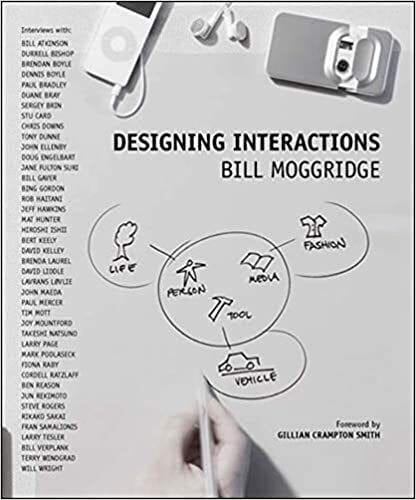When you use your phone, chances are you aren’t considering all of the science, testing, and knowledge that went into every app you open.
Designers and software engineers spend a significant amount to make sure these interactions are seamless. They consider things like different elements’ sizes, available functions, and the user’s likely actions.
This broad design area is called interaction design. It’s challenging but creative and has never been more important. If you like working on new tech while keeping humans in mind then interaction design may be right for you. Let’s go deeper into what makes up interaction design below.
What Is Interaction Design?
Interaction design, also known as IxD, is the broad practice of designing robust, reliable, and comprehensive digital products, interface designs, and more. If you are familiar at all with the two design principles of UX/UI, then this may sound familiar. While IxD stresses the need for an excellent user interface, the onus is more on the consumer’s interaction with the product.
IxD focuses on the entire product’s package. While some software designers work only on creating a robust user experience, interaction designers go further. They look at the nuances of how users physically interact with a screen or application.
Within IxD, user interactions fuel further design and progress. Bill Moggridge was the designer who introduced the concept in the 1980s. This method is especially useful in product design.
What Is Interaction Design Used For?
There are a ton of benefits to having a great design. Here are a few examples of what IxD can accomplish.
- Creating a good user experience. Our experience with programs and apps is essential for IxD. Apps can be truly confusing or very easy to use. Designers try to create the most intuitive and easy-to-use interface possible. And, if possible, they make the user’s experience fun.
- Connecting users. With a great interactive experience, companies can also better connect with users. Talented designers utilize design principles and practices to connect users to their product, with other users, or their business.
- Understanding the interaction between users and their screens. IxD uses cognitive psychology, design principles, and an understanding of pattern recognition. This unique subset of design aims to break down the walls between software and users.
Types of Interaction Design
Interaction design is much more than deciding what buttons or error messages look like. It is informed by the principles of science, philosophy, psychology, and more.
Let’s see what makes up the nitty-gritty of IxD as well as its various tools.
Usability
How easy is it to use our favorite apps? For example, does it take long to log into Instagram and like photos? Not at all. That means Instagram marketing has high usability. This concept is a metric that designers use to study and tweak how a program, website, or app works. Having peak usability means a world of difference.
If a user experiences errors, can a designer correct this with a simple patch or does it require a whole software overhaul?
Goal-Driven Design
Goal-driven design is a fantastic way to develop products. Goal-driven design can focus on accommodating the user, working in teams, finding a specific use for your product, and more. It better organizes design teams and ultimately holds them accountable for both setbacks and progress.
Learning Interaction Design

Now that we know a little more about what makes up interaction design, where do you start your education? There are a few options available to you.
You could, of course, learn IxD concepts on your own. But we don’t recommend this, as good IxD requires an excellent educational foundation. So, let’s examine how long it takes to pick up IxD, along with some great resources to help you on your journey.
How Long Does It Take to Learn Interaction Design?
Learning IxD takes six months to two years. It all depends on how well-versed you are in design principles. Those familiar with graphic design, for example, will undoubtedly have an easier time. However, anyone can learn the basics in a relatively short period.
If you have no prior experience and would like to learn Photoshop or any Autodesk programs, check out our resources for pointers.
How to Learn Interaction Design: Step-by-Step
Here are the necessary steps to turn yourself into an IxD master. Following these puts you closer to lucrative and creative job opportunities.
- Become familiar with design principles. If you aren’t already familiar with design concepts, now is the time to hit the books. Some may have an innate talent for design. But that doesn’t mean you shouldn’t learn as much as possible. IxD is a very nuanced field of study.
- Understand the different dimensions of interaction design. IxD has five primary dimensions: space, words, time, behavior, and images. Understanding all of these concepts and how they come together is crucial to perform the best design practices.
- Take an online course. The beauty of online IxD courses is that it allows users all over the world to learn from some of the most notable designers out there. Taking a free course, accessing other resources, and reading up on the subject will help immensely. Many of these also have course certificates that you can add to your resume.
- Learn the software. There is no shortage of excellent design software on the market, and all of it can assist you in learning and mastering interaction design. Knowing different programs, how they work, and how they can help you better implement design principles is essential to success.
The Best Interaction Design Courses and Training
Now let’s shift our attention to the very best ways to learn. Here are some IxD courses, books, and other resources to immerse yourself in the world of design.
Best Online Interaction Design Courses
Online classes are fantastic ways to learn from the comfort of your home. No lecture halls or 8am classes necessary.
Gestalt Psychology and Web Design: The Ultimate Guide
- Provider: The Interaction Design Foundation
- Length: 5 weeks
- Prerequisites: None
- Price: Subscription service
The Interaction Design Foundation combines the concept of Gestalt psychology and design. Gestalt means “form.” The field has students use pattern recognition, configurations, and more to understand design choices.
This course shows how intimately intertwined great design principles, cognitive functions, and psychology are. Students learn design pitfalls to avoid, the optimal ways to tap into a user’s mind, and more.
Information Visualization
- Provider: The Interaction Design Foundation
- Length: 5 weeks
- Prerequisites: None
- Price: Subscription service
Data visualization is a crucial practice when dealing with a lot of information. Since the field of big data is rapidly growing, the need for competent data visualizers is also increasing.
Learning data visualization allows you to design better while understanding the world around you. After taking this course, you will see just how dependent a lot of great design principles are on data, psychology, and more.
Best Free Interaction Design Courses
Some courses can be pretty expensive. There are, luckily, several free options on the table.
Principles of UX Design
- Provider: InVisionapp
- Price: FREE
This free IxD course uses the impressive InVisionApp. Participants receive a great introduction to user interface elements, dimensions of interaction, and app design.
While dealing more in UX, this is still a fantastic way to test the waters of a future in IxD.
Interaction Design Specialization
- Provider: Coursera
- Length: 10 months
- Prerequisites: None
- Price: FREE
Offered through the University of San Diego, this specialization in IxD is the perfect free learning option.

"Career Karma entered my life when I needed it most and quickly helped me match with a bootcamp. Two months after graduating, I found my dream job that aligned with my values and goals in life!"
Venus, Software Engineer at Rockbot
Taught by cognitive and computer science professor Scott Klemmer, students will go through four central units followed by a hands-on project.
These units are:
- Human-Centered Design: An Introduction
- Design Principles: An Introduction
- Social Computing
- Input and Interaction
This valuable information is perfect for those who want to study the connection between clients and software.
How do you achieve optimal usability? How much feedback does a user have the ability to give? This specialization will help you understand those concepts and more.
Best Interaction Design Books
Not all IxD resources are digital. Some can be found in books. Let’s see some of the best IxD books out there.
Designing Interactions (The MIT Press), Bill Moggridge

From the man who introduced the concept nearly 40 years ago, Designing Interactions is fantastic work from Bill Moggridge. Through conversations with long-time colleagues and business partners, Moggridge delves deep into seemingly simple questions about dimensions of interaction design.
Why does all of Japan use a single-service provider? Why is Google your homepage? What’s the optimal size of an app? All these topics are explored.
The book features interviews with titans of the user experience industry like Gillian Crampton Smith, Bill Atkinson, Larry Page, and Will Wright.
Overall, it’s a fantastic all-around reference for anyone in IxD.
The Inmates Are Running the Asylum: Why High Tech Products Drive Us Crazy and How to Restore the Sanity, Alan Cooper

Alan Cooper’s book offers extremely valuable insight into IxD. Cooper takes the reader on a journey, exploring technological design mishaps, how to avoid them, and ultimately how to capitalize on great design principles.
He explores the different dimensions of IxD and why talented people miss the mark when it comes to practical design and implementation.
This book is a fantastic look at the disconnect between talented designers and a great product.
Interaction Design Certifications
Course certificates are fantastic ways to show you are a talented designer. Certificates also assist you in building an impressive portfolio filled with work experience. Here are some tremendous certifications in IxD.
Professional Certificate in Human-Computer Interaction
This certification course immerses students in the complex and sometimes complicated world of cognitive and social psychology. Specifically, students learn how to develop the power of human-computer interaction and use methodologies like Agile and Active Theory.
The courses include:
- Fundamentals and design principles
- Cognition, context, and culture
- Agile methods and beyond
- Prototyping
By the end of the certification courses, students will have expertise in the unique and breathtaking human-computer relationship. Most importantly, they’ll know how to implement designs better.
CareerFoundry’s UX Design Program
Course certificates from this design program are beneficial. So much so that CareerFoundry ensures graduates will find a job within 10 months after completion.
The curriculum starts with the basics of user experiences. It then introduces software, design practices, and how to measure user interactions. Learning UX design is a great way to become an IxD master.
Students also receive comprehensive career coaching, portfolio-building resources, and job hunting tips. Students can complete this course in as little as six months.
Online Interaction Design Resources
The online resources for IxD are impressive, to say the least. What better place to study what works on the internet than on the internet? Here are the most notable outlets for designing gurus.
The Interaction Design Association (IxDA)

This is the one-stop-shop for all would-be IxD experts. Think of this as a landing page for the entire industry.
IxDA has a wealth of different resources. If you are looking for a large and diverse community, job opportunities, and local groups, IxDA is the place. There are over 120,000 members, all of who have dedicated their time towards future innovation in design. There are no memberships required. You need only access the forums or seek out a local group in your area.
Interaction Design Foundation

The Interaction Design Foundation is a fantastic outlet for designers of all stripes. Whether you specialize in UX, UI, or simple graphic design, there is something here for you. They have a great, varied, open-source library filled to the brim with reference material. They also have a lively forum to discuss anything and everything IxD.
This site offers excellent courses, great discussion, and career resources. Although it requires a membership fee, that’s relatively inexpensive and the benefits are well worth the price.
Should You Study Interaction Design?

When we log onto the internet, we are perhaps unaware of the design “magic” surrounding our experience. With the fascinating practice of IxD, you get to see how that magic is made. You’ll find out what works, what doesn’t, and the different dimensions of design.
If you consider yourself a designer who wants to learn how to create effective UX/UI, apps, and more, you must pick up IxD as soon as possible.
About us: Career Karma is a platform designed to help job seekers find, research, and connect with job training programs to advance their careers. Learn about the CK publication.



